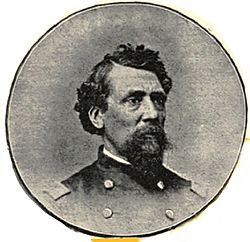Thomas Allcock facts for kids
Quick facts for kids
Thomas Allcock
|
|
|---|---|

Thomas Allcock with the 4th New York Heavy Artillery
|
|
| Born | 27 January 1815 Birmingham, England |
| Died | 28 December 1891 New York City, New York |
| Buried |
Dale Cemetery
Ossining, New York |
| Allegiance | United States of America Union |
| Service/ |
United States Army Union Army |
| Years of service | 1861–1866 |
| Rank | |
| Unit | 4th New York Heavy Artillery Regiment |
| Battles/wars | American Civil War |
| Other work | inventor, founder of the Allcock Manufacturing Company |
Thomas Allcock (1815–1891) was an amazing inventor and a brave soldier. He created a special plaster to help with pain and started his own company. During the American Civil War, he was an officer in the Union Army. He even helped decide a very important court case after the war.
Contents
Early Life and Inventions
Thomas Allcock was born in Birmingham, England, in 1815. When he was just 15, he started learning all about chemistry. In 1845, he moved to the United States and settled in New York City. There, he opened a small drug store.
In 1854, Thomas Allcock invented something really helpful: a special porous plaster. This plaster was designed to help relieve pain. It became very popular and helped him earn a lot more money. Because his invention was so successful, he later started his own business, the Allcock Manufacturing Company.
Military Service in the Civil War
Before the Civil War, Thomas Allcock joined the New York State Militia. He became a Captain in 1856 and served in that role until the war began.
Joining the Union Army
When the American Civil War started in 1861, Allcock became an Assistant Adjutant General. This meant he helped with important military paperwork and organization. In January 1862, he officially joined the 4th New York Heavy Artillery Regiment as a Major.
Key Battles and Injuries
Thomas Allcock was involved in many important battles during the war. These included the Battle of the Wilderness, Spotsylvania, Cold Harbor, and Petersburg. He showed great bravery in these fights.
In August 1864, during the First Battle of Ream's Station, Allcock was in command of a group of soldiers. He was wounded during this battle. Because of his bravery and leadership, he was later given the honorary rank of Brevet Colonel. After his injury, he was on special duty until the war ended in December 1865.
After the War
In 1866, the President of the United States, Andrew Johnson, honored Thomas Allcock again. He was nominated for the honorary rank of Brevet Brigadier General. This nomination was approved, recognizing his important service during the war.
After the war, Allcock returned to New York. He teamed up with Benjamin Brandreth to make and sell popular medicines.
Later Life and Death
Thomas Allcock passed away on December 27, 1891, in New York City, after having a stroke. He was buried at Dale Cemetery in Ossining, New York. He left behind two sons and two daughters.

